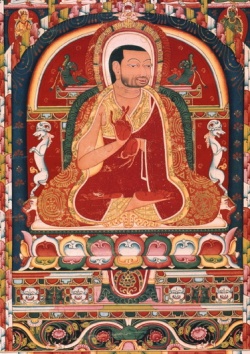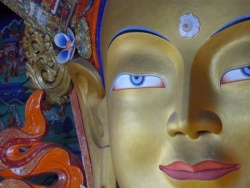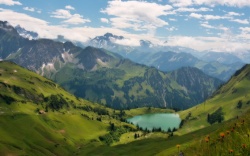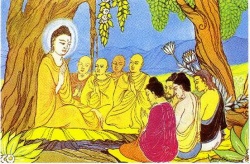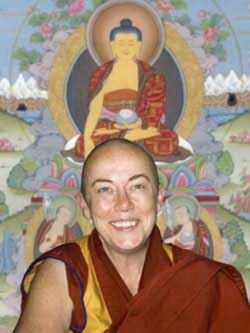Pakmodrupa Dorje Gyelpo
Pakmodrupa Dorje Gyelpo (phag mo gru pa rdo rje rgyal po) was born in 1110 and brought up by poverty stricken parents in the southern Kham.
His father was named Wena Atar (we na a thar) and his mother was 'Tsunne' (btsun ne).
They died when he was a youngster of about seven years. His one younger brother, later known by the name Dampa Deshek (dam pa bde gshegs, 1122-1192), would found a very important early Nyingma monastery in Kham called Katok (kaH thog).
It is said that before he was three, Pakmodrupa could remember how he was once a monkey during the time of the past Buddha Kashyapa. He forgot about it when his parents fed him tainted meat, but recovered this past-life memory later in life.
When his parents died, Pakmodrupa was placed under the care of his paternal uncle, a monk who also had employment outside his small monastery, Chakyi Temple (bya khyi lha khang) as a household priest (mchod gnas). This uncle sponsored his noviciate, while he in turn helped his uncle by working on a number of things, such as illustrating manuscripts.
He had a natural talent for art and calligraphy, mastered reading and writing with no difficulty. He then acted as a record keeper for the monastery's abbot, Khenpo Tsultrim (mkhan po tshul khrims) for whom he also scribed in silver letters one volume of the One Hundred Thousand Perfection of Wisdom (Prajñāpāramitā).
When Pakmodrupa was about twenty years old, taking with him a few turquoises for financing, he made the very long journey to the central parts of Tibet.
There, after his full ordination, at age twenty-five, and following several years of study in various places — at first primarily Kadampa teachers, and later teachers of practically every tantric lineage that then existed — he found a teacher to whom he would devoted about twelve years of his life.
This was one of the most renowned early tantric masters of the Sakya school, Sachen Kunga Nyingpo (sa chen kun dga' snying po, 1092-1158).
During his time with Sachen he primarily studied and practiced the Lamdre (lam 'bras). He composed a compendium of Lamdre teachings, which still survives, called the Pedzodma (dpe mdzod ma).
He next spent two years with Gampopa Sonam Rinchen (sgam po pa bsod nam rin chen, 1070-1153), a close disciple of Milarepa.
At first, when he went to Gampopa's seat, Daklha Gampo (dwags lha sgam po) together with Zhang Yudrakpa Tsondru Drakpa (zhang g.yu brag pa brtson 'grus grags pa, 1123-1193) Gampopa was indisposed and not receiving visitors, so he spent four days carrying earth and stone for building a chorten.
As a result, he was able to receive teachings and, under Gampopa he is said to have attained full realization of Mahāmudrā.
His years of restlessly seeking spiritual guidance came to a decisive conclusion. Some of Pakmodrupa's dialogs with Gampopa about meditation may still be read today.
A hermit in an area to the east of city of Tsetang (rtses thang), a place called Pakmodru (phag mo gru) which means ‘Sow Crossing,' handed over to him his meditation hut. It was a place of great natural beauty, with plenty of juniper trees. Gradually other meditators came there and built their own huts, which formed the original nucleus for the Densa Til (gdan sa thil) Monastery.
This would become the ‘mother' monastery for hundreds of other monasteries, and in these early times it was often called simply Densa, “The Headquarters.” Densa Til may still be visited today, although it has lost almost all its former splendor.
During the time that Tibet was ruled by the Pakmodru Dynasty (1350-1481 CE), the magnificent chortens that served as their royal tombs were built here.
On the other hand, the place where the simple grass with willow framework meditation hut of Pakmodrupa once stood — it survived until the middle of the twentieth century — is still considered the most holy site in the monastery.
It is from the place name Pakmodru that both Pakmodrupa and the later Pakmodru Dynasty received their names. When Pakmodrupa taught there, it is said that the monks would cover the ground of his route from his hut to his teaching chair with their hats, clothing and katak scarves.
Monks were attracted from far-flung places due to widespread reports that, with scarcely any exceptions, those who attended Pakmodrupa's teachings would all have very powerful meditative experiences.
The following is a brief sample of Pakmodrupa's teachings, with their emphasis on meditation. It is taken from the Jewelled Ladder (rin chen them skas):
The persons who rely [on these philosophies) may have achieved certainty through their own intellects in their various diverse views, but since they have neither understood nor realized these through meditation practice, theirs are views devoid of realization.
Not just for three limitless eons, but even for a million they may follow their procedures. Still, there is no squeezing oil from husks.
They may plow and hoe the winter ground, but come spring there will be no result.
Those who want to go east waste their steps going west.
People suffering from the sweltering heat desire shade, but surely, if they go again and again to bask by the bonfire, they will just go on suffering from the heat.
Pakmodrupa viewed himself as a servant of all sentient beings, and whatever donations he received went to the welfare of the entire monastic community. He ate the same food as the others. He was very strict about his personal observance of the vinaya rules and expected the same from his community.
He did not consider any task too lowly, and was known to carry water and gather ashes. He went on begging rounds with the other monks, a practice well known in Theravada Buddhist countries, but exceptional in Tibet. He was in the habit of keeping in seclusion during the waning phase of the moon, but during the waxing phase he would give teachings every afternoon.
Many of these teaching sessions called tsogcho (tshogs chos) were recorded in writing, and they make for fascinating reading.
When Pakmodrupa died in 1170, the event was accompanied by a number of wondrous signs of his sainthood. About 1600 monks attended his funeral.
His many lay and monastic followers decided to build a chörten to enshrine his remains. A team of Newar artisans, headed by Manibhadra, did much of the work on it.
Besides portraits of the Mahasiddhas, it had 2,170 images of various forms of Buddha.
The lineage of Pakmodrupa is commonly called the Pakdru Kagyu (phag gru bka' brgyud),
or this term is used as a way of including all the lineages that descended from his disciples.
The most important and the best known of these lineages or schools were the Drukpa Kagyu,
which came from his disciple Lingrepa Pema Dorje (gling ras pa pad+ma rdo rje, 1128-1188);
the Drigung Kagyu, which came from Jikten Gonpo Rinchen Pel ('jig rten mgon po rin chen dpal, 1143-1217);
and the Taklung Kagyu from Taklungtangpa Tashi Pel (stag lung thang pa bkra shis dpal, 1142-1209/1210).
The other five disciples who are credited with establishing separate traditions of Kagyu traditions (or for being the teachers to the founders) are:
Marpa Sherab Yeshe (smar pa shes rab ye shes, 1135-1203),
founder of the Martsang Kagyu;
Gyergom Tsultrim Sengge (gyer sgom tshul khrims seng+ge, 1144-1204),
founder of the Shukseb Kagyu; Gyeltsa Rinchen Gon (rgyal tsha rin chen mgon, 1118-1195),
founder of Tropu Monastery, the seat of the Tropu Kagyu initiated by his disciple, Tropu Lotsāwa Jampa Pel (khro phu lo tsA ba byams pa dpal, c.1172-1225/1236);
Yabzang Choje Chokyi Monlam (g.ya' bzang chos rje chos kyi smon lam, 1169-1223),
founder of the Yabzang Kagyu; and Yelpa Yeshe Tsek (yel pa ye shes brtsegs, 1134-1194), founder of the Yelpa Kagyu.
Sources
Roerich, George, trans. 1996. The Blue Annals. 2nd ed. Delhi: Motilal Banarsidas, pp. 552-563.
Tucci, Giuseppe. 1956. To Lhasa and Beyond. Rome: Istituto poligrafico dello Stato, pp. 127-9.
Khenpo Könchog Gyeltsen. 1990. The Great Kagyu Masters. Ithaca: Snow Lion, pp. 204-19.
Khenpo Könchog Gyeltsen, 1986. Prayer Flags: The Life and Spiritual Teachings of Jigten Sumgön. Ithaca: Snow Lion, pp. 22-28.
'Jig rten mgon po. 2001. 'Gro mgon phag mo gru pa'i rnam thar nyam len rin chen mi zad pa rgya mtsho'i gter. In The collected works (bka' 'bum) of kham gsum chos kyi rgyal po thub dbang ratna sri (skyob-pa 'jig-rten-gsum-mgon). New Delhi: DrigungKagyu Ratna Shri Sungrab Nyamso Khang, vol. 3, p. 219-255.
Dan Martin August 2008
